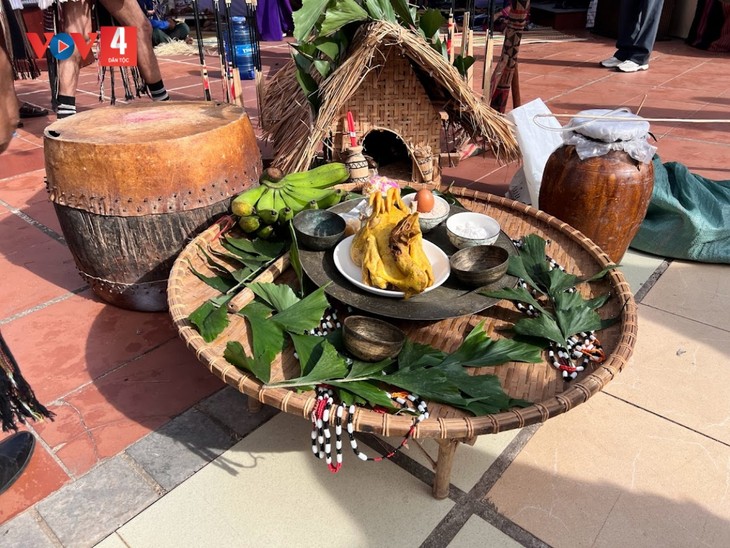(VOVWORLD) - Ethnic minorities in the Central Highlands have a ritual to give a new-born baby a name when child is 1 to 3 months old, and then hold a ceremony called “blowing the baby’s ears”. The participants blow best wishes and compliments into the baby’s ears and pray to the gods and ancestors to bless and protect the child.
 The offerings for the “Ear-blowing” ceremony. (Photo: VOV) The offerings for the “Ear-blowing” ceremony. (Photo: VOV) |
“Blowing the ears” is an important ritual to mark a transitional stage in the life of the newborn, demonstrating to the gods that from now on the family and the community have a new member. Ethnic minority Central Highlanders believe knowledge comes in through the ears and every newborn must experience an ear-blowing ceremony to receive knowledge.
Bui Ngoc Quang, Deputy Director of the Vietnam Museum of Ethnology, said that almost every ethnic group in the Central Highlands holds the ear-blowing ritual.
“They say as a baby under one year old can’t talk, he or she must absorb the community’s culture and traditions to become a member of the community. For Central Highlands people, individuals, the family, and the community are closely intertwined and inseparable. The ear-blowing ritual, although aimed at one family member, is actually for the whole community,” said Quang.
After the mother gives birth to the child, the family begins to prepare offerings to the gods and ancestors, such as chicken, pork, fruits, and confectionaries. Wealthy families may include beef. Next to the altar, the homeowner erects a small Neu bamboo pole, which is painted with colorful images.
“A small Neu bamboo tree is planted near the altar. Through this sacred item, we invite deities and ancestors to attend the ceremony,” said Dinh Po Ly, head of the Ba Na group at the Vietnamese Ethnic Culture and Tourism Village on the outskirt of Hanoi.
The child's parents usually invite a shaman or a midwife to host the ceremony, but sometimes they do it themselves. The ear-blowing ceremony is usually held in the afternoon, but the midwife and family members are invited to come in the morning and have lunch.
After they finish the meal, the ear-blowing ceremony begins. The midwife uses a hollow bamboo tube about 30 cm long to blow softly on the right ear, then the left ear, of the child while repeating best wishes and compliments for the child. Then the parents, relatives, and neighbors say some nice words to the child. If it’s a girl, they wish her beauty and skill at cooking. If it’s a boy, they wish him skill at hunting and protecting the village.
“The parents choose an auspicious day to hold the ear-blowing ceremony. The master of ceremony informs the gods of the ceremony, then blows and speaks nice words into the baby’s ears. The parents and relatives also say good things to the newest member of the community,” said Bui Ngoc Quang, Deputy Director of the Vietnam Museum of Ethnology.
After everyone gives their blessing, the master of ceremony wipes a little liquor on the child's mouth and forehead to end the ritual. Everyone moves on to having a meal followed by singing and dancing. The guests give gifts to the parents and the baby. It doesn't matter what the gifts are, they show thoughtfulness and caring for the child.
About a week after the ear-blowing ceremony, the mother takes the child to visit relatives, who give the child gifts such as a hoe, a string of beads, some cotton balls, or threads, small gifts with a symbolic meaning to wish the child health and sufficiency in the future.